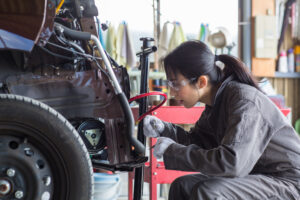
Skilled trade exec: Businesses must use available resources to find workers
By onEducation
Trades employers such as collision repair shops must tap into their available resources to help fill the skilled worker shortage, according to the head of a Canadian nonprofit focused on promoting careers in the skilled trades.
“They can become more engaged with the whole process,” Ian Howcroft, CEO of Skills Ontario, told human resources publication HCA Mag. “We often find that they have not been able to, or haven’t considered, or don’t know how to hire an apprentice… The Ontario government has done a lot of work to create Skilled Trades Ontario to have a one-stop shop purveyor of information and assistance that individuals… and employers can use to find out what they need to do, what they can do, what are the alternatives.
“There are grant programs and tax credit programs for those that hire an apprentice and work on an apprentice.”
One provincial resource offers businesses up to $17,000 in incremental payments when apprentices meet milestones. Federally, additional funds are available through:
-
- The Apprenticeship Job Creation Tax Credit, which offers businesses up to $2,000 per year, per apprentice during the first two years of an apprenticeship. Auto body and collision training are included in the list of qualified trades; and
- Wage subsidies that exist to help businesses hire the right workers.
Skilled training grants are also available in the U.S. through the Department of Labor’s employee and training administration.
Last July, in announcing a new skilled training program, the Canadian government said about 700,000 skilled workers are expected to retire nationwide by 2028, “creating an ever-growing need to recruit and train thousands more.”
In the U.S. more than 113,000 entry-level collision technicians will be needed between now and 2026, according to TechForce Foundation’s 2022 Transportation Technician Supply & Demand Report.
In 2021 alone, more than 232,000 techs were needed across automotive, diesel and collision but schools were graduating just 42,000, according to TechForce.
A number of efforts are underway throughout the U.S. in the private and public sectors to help bridge the gap though a variety of initiatives.
However, Howcroft’s conversation highlighted how businesses can be incentivized to train new workers through grants that can help offset the cost of training and on-boarding apprentices.
In the U.S., Ohio and Texas are among the states allocating tax credits to businesses offering education-based work experiences or hiring apprentices.
Howcroft said skilled workers will always be in high demand, and that more people are starting to recognize the opportunities that come with working within the trades.
“The future is very bright for those that have the training for a skilled trade,” he said. “There seems to be a lot more interest, a recognition that these are good careers, good career paths.
“And I think we are starting to at least deal with some of the negative stigmas that are attached to skilled trades and some technology careers.”
Meanwhile, the Society of Collision Repair Specialists (SCRS) and I-CAR have developed a survey designed to better understand what collision repair technicians think about working in the industry; specifically, job satisfaction, earning capacity, and other aspects that either encourage or diminish retention.
The survey, open until July 31, is being facilitated by Ducker Carlisle, which has been sourcing technician feedback through surveys with automotive OEMs for several years.
SCRS said it is particularly interested in information about pay structures and the potential to highlight how it may be a key limiting factor specific to the acquisition and retention of new talent in the collision industry.
SCRS and I-CAR plan to share a state of the industry report, including the survey trends, later this year.
IMAGES
Featured image credit: tdub_video/iStock
